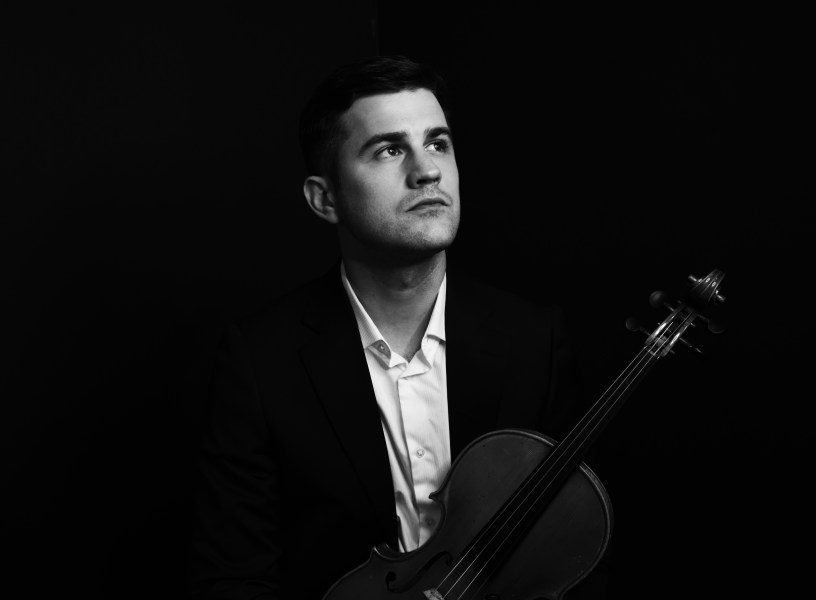The world of ‘New Music’ is a complicated one. The term itself is incredibly vague and ‘contemporary classical music’ isn’t much better. Thankfully, this hasn’t stopped ‘New Music’ label, New Amsterdam Records from continuing to produce a steady stream of recordings of fascinating new works from some of the most promising composers around. This year alone has seen particularly gorgeous releases from Caitlin Sullivan, Timo Andres, Nathalie Joachim, and now Nathan Schram – Attacca Quartet violist, composer and husband to genius singer/songwriter Becca Stevens.
Schram’s debut solo album of his own compositions, Oak and the Ghost, is a complex, textured sensory overload from the get-go. The pieces are constructed from a collection of string parts from Schram himself, often with contributions from Attacca Quartet, as well as percussion, electronics and occasionally vocal contributions from Schram and Becca Stevens. Stylistically, the compositions indicate an eclectic set of influences, from dystopic fiction (Schram notes that he was inspired by Kurt Vonnegut’s Player Piano) to film score work from the likes of Nicholas Britell and Jóhann Jóhannsson, to contemporary instrumental groups like Vulfpeck.

The opening track, ‘Boston’ has a repetitive bass groove that would evoke a contemporary funk feel if not for the beautifully textured, percussive bowing techniques, slapping strings and sweeping electronic effects. The combination of these elements results in a haunting, yet driving back drop over which Schram is able to introduce gorgeous melodic fragments, none of which ever stick around long enough to form a single, cohesive thought. The piece is a strong opening to the record, and a visceral, sensory primer for what’s to come.
‘Woljeongsa’ and ‘Oh My Heart’ are performed solely by the Attacca Quartet, and while there are still percussive elements that tie the two tracks to the album as a whole, these two pieces feel more focused on building strong harmonic identities. The former constructs often beautiful and delicate, but occasionally striking and dissonant, harmonic flourishes around a single, ever unfurling melodic idea. The latter is more subtle in its presentation. The quartet constructs interlocking layers of plucked rhythmic and harmonic foundations, over which cascade waves of sustained harmonies. The piece literally sounds like it’s breathing, confirmed further by the breathy sounds that bring the track to a zen-like close.
‘Soft’ is the most overtly film score-esque track on the record. It’s clearly defined, accessibly tonal chord changes are stylistically reminiscent of Nicholas Britell’s Oscar nominated score for If Beale Street Could Talk, and as the title suggests, the piece serves as a quiet, contemplative reprieve before the album progresses into more aggressive territory with the synthesiser and drum machine aided ‘Avion’.
The most powerful moments of the album come in Oak and the Ghost‘s final three tracks, wherein Schram steps away from the Attacca Quartet, around which the rest of the album centres, and begins to place extra emphasis on electronics and productions techniques. ‘Black Well’ is a stunning exercise in stillness, with reverberating keys being subtly augmented by synth-like vocals from Becca Stevens, weaved in as if her voice was just another layer of synth. The title track works hard to emphasise its own strangeness, with just enough out of left field diversions in its striking melody to keep the listener on edge, relentless industrial percussion, and one of the most tactile, satisfying synth basslines that hammers its way into the piece’s midpoint.
The closing track, ‘Gods Fare No Better (Epilogue)’ is a pondering blend of softly bowed and plucked strings, accordion and keys over which Schram softly croons with a Thom Yorke-esque vocal tone, quietly retreating from the violent, mechanical feel of the track the preceded it.
Schram’s vision of an industrial dystopia on Oak and the Ghost is beautifully and creatively rendered. Often, electronically infused new music compositions can feel cumbersome and forced, but Schram’s approach makes inventive use of a small quantity of musical resources to construct a textured, thoughtful and intricate machine with a staggering number of well-realised moving parts.


Really good review that helped as a listener’s guide to think about this one. It is a very challenging album to listen to, not for everyone. I could easily see this being a soundtrack for a movie like Bladerunner. While I enjoy contemporary artists like Adams, this proved another step beyond. Always welcome when worlds collide as in here with Becca.
LikeLiked by 1 person